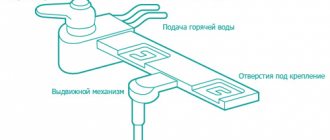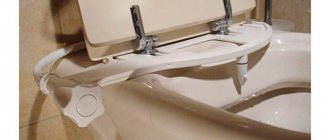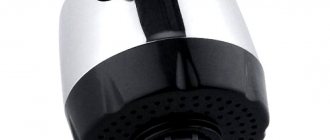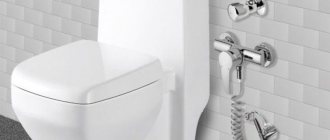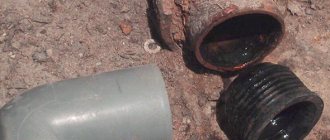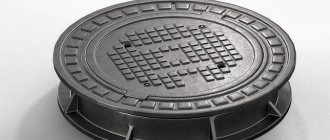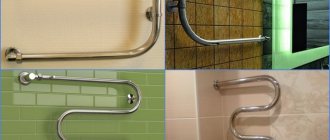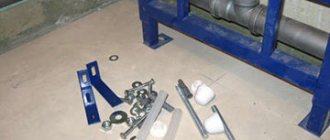assets/from_origin/upload/resize_cache/iblock/41d/600_450_2/41d3be2d479f9e77109b190aa97226af.jpg From this article you will learn:
- What types of bidets are there?
- How to install a bidet correctly
- How to install a floor bidet
- How to install a hanging bidet with installation
- How to install an electronic bidet
- What can replace a bidet?
Bidet is a very useful plumbing equipment that significantly increases the level of comfort in your home. You simply cannot do without such a device if someone in your family is experiencing health problems. The lack of such equipment is sometimes justified by a lack of finances or free space, but modern manufacturers offer various plumbing options suitable for bathrooms and bathrooms of any size. Moreover, installing a bidet is not a very complicated procedure. After familiarizing yourself with the features of installation work that are described in our article, you can easily cope with this task.
A little history about the bidet
It is impossible to say exactly when and where the bidet appeared. According to some researchers, the first mention of such a device was found in Italy. According to other sources, the invention of the bidet belongs to the court furniture makers of France. It is believed that the first examples of such equipment were located in the boudoirs of noble ladies, but there are also opinions according to which such devices were used by women in brothels.
Not only in Europe you can find references to the bidet in ancient times. The Arabs believe that it was they who first began to use this convenient invention. And proof of this fact can be the results of excavations by archaeologists, during which the remains of ancient dwellings with separate compact rooms were discovered, where bowls were built into the floor. These bowls can be considered the prototypes of modern bidets.
At the beginning of the twentieth century, the bidet ceased to be part of the interior of the boudoir or bedroom. Since that time, such a device has migrated to the bathroom. Another 80 years later, thanks to the development of technology, electronic devices began to be produced in Japan. Many consumers are familiar with a bidet as a bowl that resembles a toilet, to which a faucet is attached. Such examples of models of this equipment are quite widespread in our time.
In countries that were formerly part of the Soviet Union, bidets are not found in bathrooms as often as in Turkey, Italy, France, Spain or Greece.
Particular attention is paid to personal hygiene in Muslim countries. Here this is not only a personal matter, but also part of the issues from the religious sphere. There is often no toilet paper in the bathrooms of countries such as the UAE, Kuwait, Iraq, and Saudi Arabia. Its functions are performed by a bidet.
It may seem strange that in developed North America this equipment is not as common in bathrooms as in the countries of the southern neighbors of the United States.
Japan is considered the real leader in the level of bidet use. Many residents of the Land of the Rising Sun cannot imagine daily life without this plumbing equipment. As in other areas, the Japanese strive to use the latest technological developments in the production process. Electronic bidets are a common thing for them.
Dimensions of floor-standing, wall-hung, corner toilets
Types and design features
The dimensions of toilets depend on the design. So it is necessary to familiarize yourself with them. At the same time, we’ll find out which types can be installed in small bathrooms.
You don’t always immediately understand what and where
Bowl shape
Installation method
Most toilets are installed on the floor. There are regular models and wall-mounted ones. There are also hanging ones. They require a special frame, which is hidden behind a false wall. This frame is called an installation
Release
This is not all the design features. We still need to sort out the release. This is the outlet pipe through which the toilet is connected to the sewer. The most compact models with a vertical pipe outlet. The longest ones are oblique. But they are the ones that are more common, since there is no need to lift the sewer pipe, but you can only install a tee and insert a corrugation into it.
Types of toilet cisterns
Toilet tanks also affect the size. Often they are either an integral part or cast in a single mold
In general, there are three types of toilet cisterns: separate (wall-mounted), compact and monoblock. Compact and monoblock can be straight or angular. Corner models are usually the smallest. And they definitely allow you to save space in a small toilet.
The least amount of installation space is required for the dryer. This is a tankless drain system
Distances
Now you draw a plan of your bathroom, mark the minimum distances and see what size toilet will fit into your toilet. So it's simple.
Standard toilet sizes and minimum toilet size
GOST 30493-96 standardizes the dimensions of toilets with a shelf only. There are also those that are installed in cars, but we don’t need them. The standard dimensions of a toilet with a shelf are prescribed for two options: with a solid cast and with an attached one. The second model is used in conjunction with mounted/wall-mounted tanks or without them at all. There are also standard sizes for children's toilets. They (children's) come without a shelf. All sizes are shown in the table. And to understand what we are talking about, look at the drawings.
Drawing of a toilet with a solid cast shelf and an oblique outlet from GOST
| Toilet design | H | h | h1 | l | l1 | L (depth or length) | b | B (width at widest point) |
| With a one-piece shelf for installing a tank (Compact) | 150 | 330 | 435 | no less than 605 (maybe 575 mm) | 260 | 340 and 360 | ||
| Without shelf (mounted tank) | 370 and 400 | 320 and 350 | 460 | |||||
| Children's | 335 | 285 | 130 | 280 | 380 | 405 | 210 | 290 |
And the length of the toilet should be 575 mm + 600 mm = 1175 mm. But this does not take into account the fact that it is also necessary to lay a sewer pipe and somehow connect the drain. We will allocate another 20 cm for this. In total, we find that the minimum length of the toilet room is 1175 mm + 200 mm = 1375 mm. In meters it is 1.375 m.
Standard dimensions of a toilet without a shelf (with a hanging cistern) from GOST
What sizes are toilets?
Dimensions of floor models
As you understand, floor-standing toilet models are different and their sizes are also different. We will give a range, but we do not guarantee that there are no narrower or wider ones. Most likely, if you set a goal, you can find both.
Different styles, different sizes
Compact
The Compact type toilet (with a tank attached to the back) has the following dimensions:
Note that the narrowest bowls are more like a rectangle. They are not as round as we are used to. They are quite convenient to use. There may just be problems when buying a cover. This form is rare.
Dimensions of Compact floor-standing toilets
Without tank
A toilet without a shelf with a wall-mounted or separate tank has the following dimensions:
Which bidet to choose for installation
A bidet is a modern sanitary equipment that is designed to solve personal hygiene issues. The appearance of such a device resembles a standard toilet. Technically, the equipment is similar to a low-mounted washbasin. Its drain is connected to the sewer. For hygiene procedures, the bidet is equipped with a mixer or fountain.
Depending on the installation method, there are floor-standing and hanging models.
When choosing a bidet, you need to pay attention not only to the installation option, but also to other characteristics of the equipment. Different models can be equipped with a regular, two-valve and single-lever mixer, as well as a ball mechanism (this option is considered the most convenient).
The design of the mixer spout installed on the hygienic device allows you to direct the stream upward at the desired angle. Some models don't have it at all. In this case, a fountain of water comes from the bottom of the bowl. The direction of the fountain jet can be adjusted in the desired direction. The appearance of the bowl and its design are selected based on the interior design of the bathroom.
In the manufacturers' catalogs you can find modern models of devices made in different designs - from retro products to trendy high-tech plumbing fixtures. It is worth paying attention to the size of the bowl, especially if you are choosing plumbing fixtures for a compact bathroom. It is necessary to ensure that the bidet has easy access and is convenient to use.
The most compact option is a bidet with a hanging bowl, but to install such plumbing fixtures you will need to install an installation. This support system is placed in a specially prepared niche behind the main element and can be covered with a false panel. To avoid mistakes with choosing the size of the bowl, you should use a tape measure to measure the space where you plan to install the bidet.
When choosing plumbing fixtures of this type, you need to analyze a number of parameters and characteristics.
Recommended articles on this topic:
- Arrangement of a small apartment
- Stages of renovation in an apartment
- Turnkey cosmetic repairs
As noted above, first of all you need to decide on the size of the bowl. If the dimensions of the room do not allow the installation of a separate device, you can choose universal models called shower toilets.
After choosing a product by size, pay attention to the material from which the equipment is made. The plumbing market offers bidet models made from the following materials:
- steel;
- glass;
- plastic;
- cast iron;
- silver;
- gold;
- faience;
- porcelain.
The most common are porcelain and earthenware products. Models of the first type will cost much more than earthenware ones, which is due to the peculiarities of production technology. At the same time, in terms of quality characteristics, earthenware bidets are only slightly inferior to porcelain ones (in terms of strength and durability).
It is quite difficult to distinguish models made from these materials by their appearance, especially if they are covered with high-quality glaze.
The main differences between products made from such materials are porosity or hygroscopicity. Porcelain equipment is more resistant to the formation of rust stains on the surface of the bowl and the appearance of an unpleasant odor. Earthenware plumbing fixtures can last up to 35 years, and porcelain products are designed to last more than 55 years. Saving money when purchasing earthenware bidets will be reflected in more complex plumbing maintenance. With porcelain equipment such problems will not arise. When choosing a product, you must pay attention to the absence of cracks, chips or other defects on the surface of the bowl.
Variety of designs and functionality
There's plenty to choose from here. A simple and very convenient faucet with a movable aerator regulates the direction of water. Models with a built-in thermostat automatically maintain the set water temperature. Improved devices deliver a jet of different intensities (soft, intense, pulsating, even saturated with air).
It is advisable to choose a bidet with a built-in heating element. Such a device will supply warm water even if it is turned off in the water supply network. This is important for city residents, where warm water is often supplied/disconnected on a schedule. It would be good if the model is equipped with a high side around the area with the tap. It will prevent water drops from dripping onto the floor.
Depending on the configuration, bidets may have additional options:
- heating water;
- drying function;
- seat heating;.
- massage functions;
- air purifier;
- backlight;.
For lovers of high-tech interiors and comfort, bidets are available with a micro-lift system, remote control, with an anti-dirt coating, an anti-splash function, drying, lighting, automatic adjustment of pressure, temperature of water and hair dryer air, with massage, a self-cleaning rod for hygienic washing, etc.
General tips for installing a bidet yourself
Connecting a bidet to the sewer system is not a very complicated process. You can do it yourself without any special skills. Here are step-by-step instructions to help you install the bidet correctly.
Before proceeding with the installation of equipment, it is necessary to accurately determine its location. Pay attention to the dimensions of the plumbing fixture and the distance to the points of connection to the water supply and sewerage. To perform installation correctly, free access to the pipes is necessary.
To install a bidet yourself, you will need silicone, mounting tape, tow, as well as plumbing tools - a pipe wrench, a hammer drill, a set of drills, open-end wrenches and a screwdriver.
During the installation process, you should strictly follow the instructions provided in the manufacturer's instructions, which are usually supplied with the product. In such a document you can also find a detailed diagram of connecting the bidet to communication systems.
Standard models of hygienic devices are connected to the water supply network and sewer riser in the same way as conventional sinks. Almost all types of such plumbing provide for the installation of automatic drain valves and there is no connection to a siphon.
To install a floor-mounted bidet, special fasteners for toilets are used. They are connected to the sewer system with a flexible tube and a shaped element. In models that are equipped with faucets, these devices are installed last before connecting to the water pipe.
Bidet dimensions are standard in the drawing
SANITARY CERAMIC PRODUCTS
Classification and main dimensions
Sanitary ceramic wares. Classification and basic dimensions
Preface
The goals, basic principles and general rules for carrying out work on interstate standardization are established by GOST 1.0 “Interstate standardization system. Basic provisions" and GOST 1.2 "Interstate standardization system. Interstate standards, rules and recommendations for interstate standardization. Rules for the development, adoption, updating and implementation of the Scientific Research Institute of Sanitary Engineering" (JSC "NIIsantekhniki")
2 INTRODUCED by the Technical Committee for Standardization TC 465 “Construction”
3 ADOPTED by the Interstate Council for Standardization, Metrology and Certification (protocol dated September 25, 2021 N 103-P)
The following voted for adoption:
Short name of the country according to MK (ISO 3166) 004-97
Abbreviated name of the national standardization body
Ministry of Economy of the Republic of Armenia
* The text of the document corresponds to the original. — Note from the database manufacturer.
4 By Order of the Federal Agency for Technical Regulation and Metrology dated October 12, 2021 N 1404-st, the interstate standard GOST 30493-2017 was put into effect as a national standard of the Russian Federation on March 1, 2021.
6 REPUBLICATION. December 2021
Information on the entry into force (termination) of this standard and amendments to it on the territory of the above states is published in the indexes of national standards published in these states, as well as on the Internet on the websites of the relevant national standardization bodies.
In case of revision, modification or cancellation of this standard, the relevant information will be published on the official website of the Interstate Council for Standardization, Metrology and Certification in the catalog “Interstate Standards”
Introduction
This standard applies to sanitary ceramic (porcelain, semi-porcelain and earthenware) washbasins, washbasin pedestals, toilets, cisterns, bidets, urinals and establishes their classification and basic dimensions.
1 area of use
Ceramic sanitary products are intended for installation in sanitary units of buildings for various purposes.
2 Normative references
This standard uses normative references to the following standards. For dated references, only the edition of the referenced standard applies; for undated references, the latest edition (including any amendments) applies:
GOST 13449 Sanitary ceramic products. Test methods
GOST 15167 Sanitary ceramic products. General technical conditions
GOST 21485 Flush cisterns and fittings for them. General technical conditions
3 Types and main sizes
3.1 Ceramic sanitary products (washbasins, toilets, flush cisterns, bidets, urinals) are manufactured of the following types in accordance with the requirements of this standard according to approved working drawings. It is allowed to produce ceramic sanitary products of other sizes and types in accordance with working drawings developed and approved in the prescribed manner.
Elements of the main products are given in Appendix A.
3.2 The shape of products is not regulated by this standard.
3.3 Washbasins
3.3.1 Types of washbasins
Washbasins are divided into washbasins with overflow, without overflow, with and without backrest: semicircular, round, oval, rectangular, trapezoidal, asymmetrical, corner, surgical and hairdressing.
3.3.2 The main dimensions of semicircular, round, asymmetrical, furniture, oval, rectangular and trapezoidal washbasins are shown in Table 1 and Figure 1.
Features of installing a floor bidet
Floor-standing bidet models have a number of advantages:
- Possibility of hidden connection to communications. After installing such equipment, pipes and taps remain invisible, so the bathroom interior will look more attractive. All connection points of such models are easily hidden due to the tight fit of the device to the wall.
- Floor-standing plumbing allows you to rationally use the space of the bathroom. The shape of the bowl in this case will be more compact and therefore takes up less space.
- Simple installation is another advantage of a floor-standing bidet. It includes only two components, which, following the instructions, can be easily installed, even without professional skills.
As additional advantages, it is worth noting the reliability of the design, silent operation and easy maintenance.
The most significant disadvantage of floor-mounted bidets is their high cost. Such models will cost much more than hanging products.
Before you begin installing a new bidet, you should carefully check the package contents and make sure the product is intact. There should be no chips or other defects on the surface of the bowl. To perform installation work and connect plumbing, you must prepare the following tools:
- drill;
- drills for concrete and ceramics;
- set of open-end wrenches;
- adjustable wrench;
- sealants for threaded connections;
- silicone sealing compounds for connections operating in high humidity conditions.
After the tools and materials are prepared, you need to determine the location of the bidet. To do this, you will need to accurately measure the distance from the bowl to the connection points to the water supply and sewer system. The bidet should be installed on the base and the locations of the fasteners should be marked. At the marked points you need to drill holes with a diameter corresponding to the size of the plastic dowels.
If the equipment is installed on a ceramic tile floor, then it is recommended to use a special pen drill to make holes. Dowels should be installed in the resulting holes, and the bowl should be placed on top and secured with fastening bolts. To avoid damaging the protective coating of the bowl, use special rubber gaskets.
When tightening the bolts, the force must be calculated correctly so that the ceramic does not crack. At the same time, not tightening it tightly enough will result in the bowl not being very stable. To strengthen the fixation of the plumbing fixture to the floor, you need to use silicone sealant. This mixture is applied to the gap between the bowl and the floor.
When the bowl is secured, we proceed to installing the mixer. For different models, the mixer can be mounted on the side of the bowl or on the wall. Instructions for installing the mixer and all the necessary fasteners, as a rule, are also included in the plumbing kit. As noted above, you need to check the equipment when purchasing equipment.
To install a faucet on a wall, you usually need to do work on the surface near which the bidet will be located. The grooves should be arranged before installing the bowl so as not to damage the product. Along with the markings for fastening the bowl, you should also mark the installation location of the mixer on the wall.
A hole must be drilled at the marked points. Then you should carefully remove all construction debris and only then proceed to installing the bowl. Installing the faucet on the side of the bidet will be simpler, since the bowl already has mounting holes for it.
To install the faucet, a rubber gasket and a clamping nut are used, which should be carefully tightened using an adjustable wrench. When the mixer is installed, it is necessary to connect cold and hot water. In this case, you need to be careful not to confuse the pipes connected to the mixer.
Experts believe that ball mixers are best suited for bidets. But such products are usually used to complete modern models of plumbing fixtures. Bowls, made in retro style, are equipped with mixers with two valves.
The bidet mixer is connected to the water supply using a flexible hose in a metal braid. It is necessary to select the hoses according to their length so that they are not excessively long, as in this case unnecessary loops will form. At the same time, using a short line will result in the hoses being too tight, and this is an unacceptable mistake when connecting a hygienic device.
It is recommended to connect the bidet mixer to the water pipes using a shut-off valve. This will allow you to turn off the water supply to the device if necessary.
To connect flexible hoses to cold and hot water, you need to insert or install tees, in front of which shut-off valves are installed. If it becomes necessary to replace the faucet or perform other types of equipment repairs, you will not need to shut off the entire water supply system in the house.
The bidet is connected to the water supply using threaded connections. To avoid leakage, they should be well sealed using linen thread, FUM tape or other materials. Inexperienced workers make two mistakes at this stage: they use either very little or too much sealing material. The optimal amount will be if, after screwing the thread, the sealing material protrudes slightly outward.
After connecting to the water supply, the equipment must be connected to the sewerage system. It is imperative to install a siphon. To connect to the sewer system, you will need a rubber adapter sleeve and corrugation. The siphon is installed first on the rubber gasket. All modern bidet models have overflow protection. During installation, you must ensure the integrity of the product and the correctness of all connections.
After installing the siphon, a corrugation is mounted to it, the second end of which is connected to the sewer pipe. The connection is sealed with a rubber cuff. Once the installation of the hygiene device is complete, turn on the water and check the connections for leaks.
How to choose a lid and toilet seat
To choose a suitable toilet seat, you need to know exactly the dimensions of the plumbing fixtures. It is believed that the lid should exceed the dimensions of the toilet by about 0.5 centimeters , however, this is not a necessary condition. To make accurate measurements, you need to find out three main parameters:
Distance between mounting holes.
The length from the fastening axis to the end of the cover.
Distance from the mounting axis to the outer rim of the toilet.
In addition, you need to take into account an important nuance: the shape of the lid must match the rim of the toilet.
Seat - pad with handrails
Convenient modifications of lids with handles are provided for disabled people:
What is this mysterious microlift?
For ease of use of plumbing fixtures, additional accessories are sometimes included in the design of the toilet. One of these elements is a microlift. According to technical parameters, a microlift is similar to a regular door closer and performs similar functions. The task of the microlift is to ensure smooth lowering of the lid onto the toilet rim, excluding sharp impacts that can damage the toilet seat and ceramics.
Toilets with a microlift can be found in any plumbing store; the installation of this element has virtually no effect on the cost of the product.
Step-by-step installation of a hanging bidet
Installation of a bidet with installation is carried out using the same technology that is used for other hanging plumbing fixtures. In this case, the connection diagram of the hygienic device will differ from floor-standing models. It includes the following steps:
- Installation of the installation system. First, you need to make a small recess in the wall on which the bowl will be attached. Its dimensions should be slightly smaller than the dimensions of the bowl. It is necessary to provide sewerage and water pipes to the installation site. Then the installation is assembled. This must be done strictly according to the instructions. After installing the installation on the floor and on the wall of the bathroom, it is necessary to mark the future fastening and drill holes for the nuts. Then we proceed to fix the installation. To close the niche where the metal support system is installed, plasterboard, special decorative panels and other materials are used.
- The next step involves attaching the bidet bowl. The provided mounting holes hold the pins that hold the bowl. These studs are attached to the back wall. The installation kit includes a special gasket to protect the product from damage. If there is no gasket included in the bidet kit, it can be replaced with silicone sealant. It is applied to the bowl fasteners, after which you need to wait until the sealant has completely dried and secure the bowl with nuts.
- When the bowl is fixed, you need to connect the bidet to the sewerage system and water supply. The device manufacturer's instructions are also useful here. The essence of the installation work is that you need to initially install the mixer. It is better to use a built-in mixer model. The outputs/inputs of the hygienic device are connected to communications using flexible hoses. You need to remember about the tightness of the connections. Special gaskets can be found in the equipment package. They are installed at the ends of the hoses.
As practice shows, the use of gaskets is not enough to avoid leaks during operation. You need to additionally wind FUM tape between the thread and the hose. This solution will ensure maximum connection tightness.
- The next stage is related to the installation of the siphon. It is connected to the bowl drain holes. Rubber rings must be installed between the plumbing fixtures and the siphon to ensure a tight seal when draining water. The outlet of the siphon must be inserted into the sewer outlet, which must first be brought to the installation. With this method of installing a siphon, it is always easy to replace the bowl or repair it without much difficulty.
Design, shape and color
The white classic remains a hit. If the room requires accents on an unusual color of plumbing, then you can find an accessory in the desired tone: pink, light green, blue, black, chocolate brown, gold-plated, orange, bright red.
Today, decorated models with patterns, drawings on the bottom of the device, external cladding with mosaics of the same color or colored ones are popular. For a classic style, pearl white remains the best color.
For Japanese-style interiors, round-shaped sanitary ware in black design is installed. Dark bidet colors are also used for the bathroom in trendy minimalism. Models in contrasting designs, for example, black and white, red top and white bottom, look original. For country-style rooms, semicircular bowls in a light tone, decorated with a delicate pattern, are suitable.
Installing an electronic bidet
Installing an electronic shower toilet is the same as installing a traditional toilet. The difference between this process is the need to connect to the electrical network.
Mandatory requirements for installing electronic bidet models:
- Grounding must be provided to prevent the occurrence of excess electrical current, which can be dangerous to humans.
- It is necessary to provide for the installation of a protective disconnection device from the network in case of power surges.
- It is necessary to provide a separate power supply branch.
The procedure for installing an electronic bidet depends on the type of bowl, which can be floor-mounted or wall-mounted.
The main stages of installing a wall-mounted or wall-mounted bidet with electronic control:
- First you need to prepare the place where the bowl will be installed. It is best if the installation is carried out to the wall in which the water pipes pass.
- If it is not possible to equip a niche, then you can make a plasterboard structure to replace it. For such work, exclusively moisture-resistant drywall is used.
- The installation frame for hanging models is attached to four points (two on the floor and two on the wall).
- Anchor bolts are used to secure the bowl.
- You can concrete the legs of the installation frame. To strengthen the frame of the metal support system, use special jumpers.
- Before carrying out installation work, experts recommend determining the optimal height for installing the hanging bowl, taking into account the height of all family members.
- After completing the installation of the hanging electronic bidet, do not forget to check the operation of the installation, after which you can begin plasterboarding or concreting.
- At the final stage of installation, special studs are installed to ensure the reliability of the structure.
How to choose a bidet
There are a variety of bidet models available in stores; they differ in installation method and material of manufacture. Here are some tips for choosing:
- It is advisable to purchase a toilet and a bidet at the same time. In this case, you can select models from the same series. They will have the same design, and the interior will look harmonious.
- If you plan to purchase a bidet later, then it is worth remembering the manufacturer of the toilet, its model and article number. Then, based on these indicators, you can easily select the appropriate bidet model.
- Based on the type of installation, plumbing fixtures are divided into floor-mounted, wall-mounted and wall-mounted. In the first option, the pipes supplied to the bidet are located openly; in the case of a wall-mounted installation, the pipes are hidden in the wall, and in the third installation option, the pipes are built into the body.
Typical bidet installation mistakes
- To operate effectively, the sewer system must have a certain pipe slope. It should be taken into account that when laying a pipe from the sewer riser to the installation site of the equipment, the angle of inclination of the section should be about 15° or from 3 to 5%. These requirements must be observed when rearranging all types of plumbing fixtures (sinks, toilets, bidets, showers, etc.). If you need to move the drain of any equipment from the riser to 2 meters, then it will have to be raised by 60–100 mm.
- To connect to the sewer riser, you need to provide convenient access to the siphon connection point to the sewer joint and the drainage point.
- Check for sewer slope when installing the bidet. The water should flow by gravity into the drain hole. The sewer system must be completely sealed.
- Incorrect adjustment of the mount may cause it to tilt to the side.
- Do not install the bidet on an uneven surface or fix the bowl loosely.
- Silicone sealants are used to seal the gap between the wall and the bowl of the hygienic device.
- At the points where the siphon connects to the drain or sewer, traces of leakage may appear. In this case, you need to check the integrity of the siphon and seal the joints with sealant.
What is a bidet?
The appearance of a bidet is very similar to a toilet. Therefore, it is recommended to buy these two plumbing units together in order to maintain the same style. However, nowadays the range of plumbing fixtures is so wide that if you already have a toilet installed and you need to buy a bidet separately, then there will be no problems with choosing the right model.
However, despite its similarity with a toilet, a bidet performs other functions and has its own design features :
- bowl , which, in fact, determines the similarity with the toilet;
- a characteristic drain hole that connects to sewer pipes;
- faucet with mixer;
More expensive bidet options are equipped with additional equipment :
- aerator;
- thermostat - for automatic adjustment of water temperature;
- drying;
- seat heating;
- deodorization;
- massage.
Some models are designed in such a way that a stream of water is supplied from a hole located in the center of the bowl.
In most cases, bidets do not have a lid or . In rare cases, you can find the presence of a lid, but it plays a purely decorative role. There is no seat due to the fact that the bidet is washed with warm water, thanks to which the design is warm and pleasant to the touch. Therefore, using a seat is not advisable.
Separately, I would like to dwell on the drainage system . In a bidet, the drain is similar to a regular washbasin. The holes are closed automatically by the corresponding plugs, and the opening and closing of the drain occurs due to levers that are located near the mixer. Modern bidets are equipped with an anti-flooding system, so if a blockage occurs, you don’t have to worry about water spilling over the edge. Some models have a pipe installed instead of a ceramic drain.
bidet mixer In order to regulate the direction of the water jet, there is a so-called perlator at the very edge of the ball bend. This device provides the convenience of using a bidet.
The water temperature can be adjusted either manually or by installing an electronic mixer that supplies water at the desired temperature automatically.
There is such a device as a thermostatic battery , it allows you to maintain the optimal set temperature in the system. Sold and installed separately from the bidet. A very handy gadget if you want to make your life easier.
Children's toilets
Plumbing designed specifically for children is quite rare these days. However, it has many advantages, especially in cases where there are several children in the family. In fact, it is much easier to initially accustom your baby to a real toilet than to do it in several stages. So, often mothers have to first potty train their children, and only then they will need to train them to use the toilet.
Currently, manufacturers offer similar options - both in floor-mounted and suspended versions. Of course, the sizes here are much smaller, but this is not their only difference. They also boast a bright design that will interest the child and make toilet training easier.
Recommendations for choosing a bidet – which form is most convenient?
The range of shapes and dimensions of plumbing fixtures allows you to furnish the toilet room as comfortably, conveniently and at the same time as fashionable.
The most convenient and practical option are models with an oval bowl. If the stylistic direction of your bathroom requires different plumbing, you can choose a rectangular or square bidet.
There are exclusive models that represent designer delights. But they will cost many times more than the classic options.
A proven option is to choose a bidet from the same brand as the toilet. Then the design of the toilet room will have a finished look, and the plumbing fixtures will be compatible with each other in style, color, and size.
These simple rules for choosing a bidet will allow you to purchase a truly high-quality and at the same time aesthetically attractive product.
